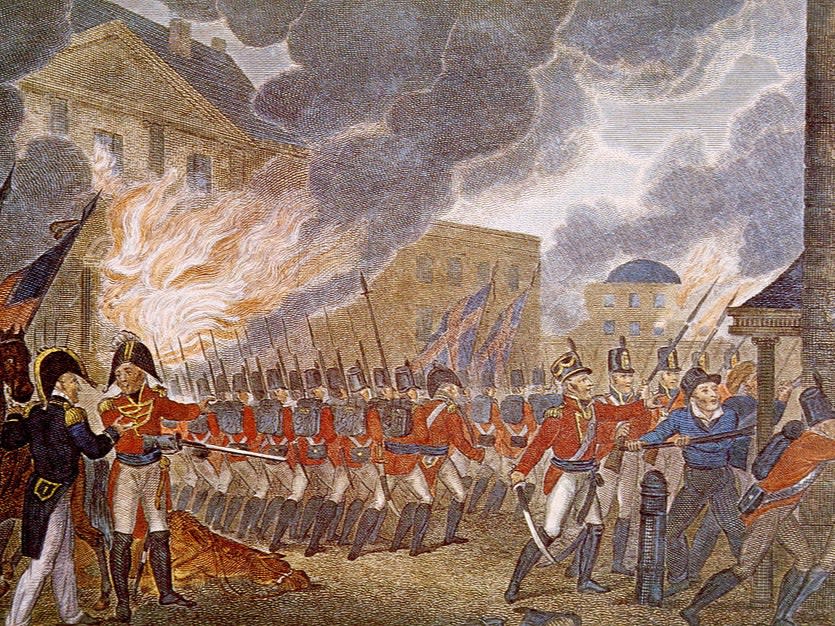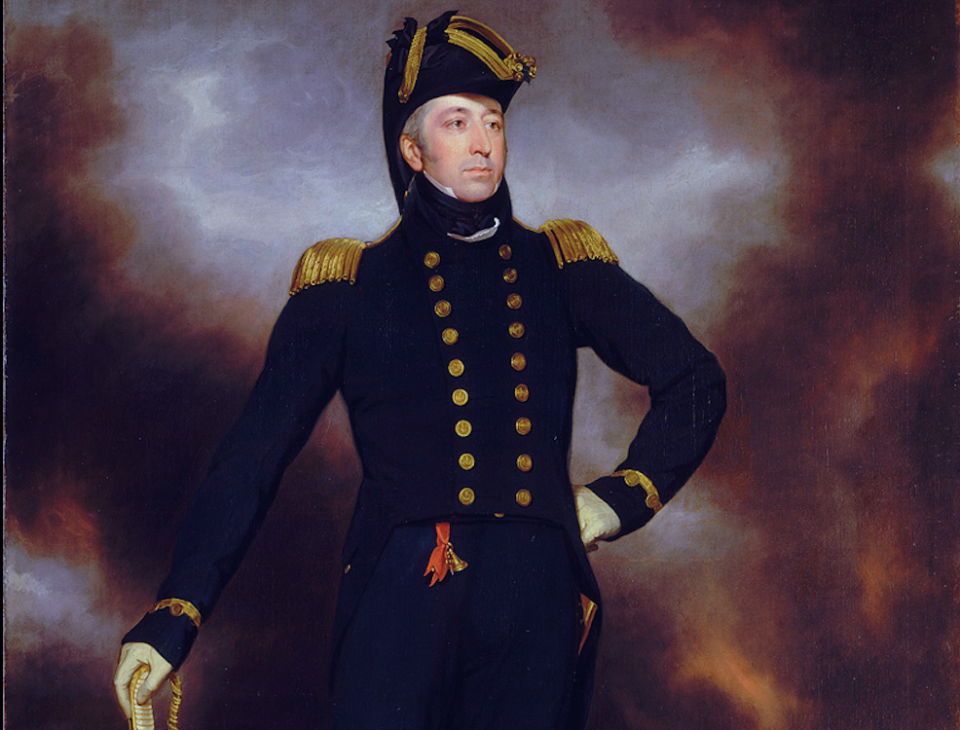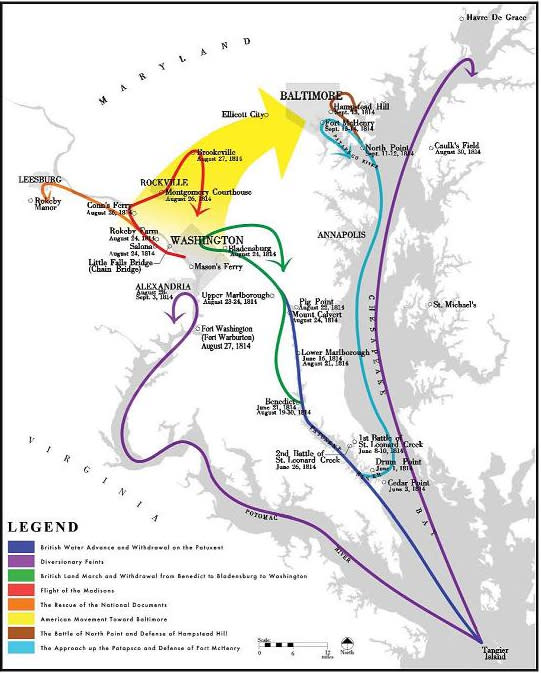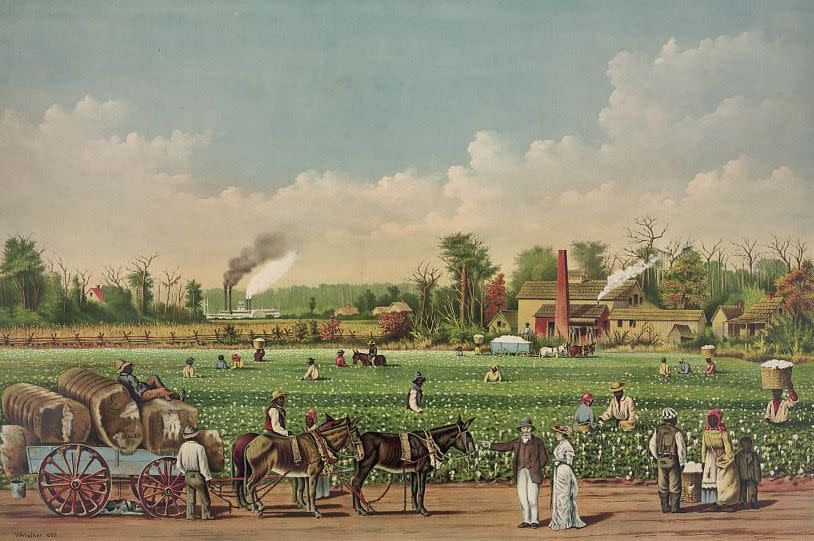How freeing the slaves enabled the British to burn Washington

Amid the patriotic bombast about Making America Great Again at the Republican Convention nominating President Trump for a second term on 24 August, nobody noticed that it began on the anniversary of one of the most humiliating defeats in American history. It was on this day more than two centuries earlier in 1814 that a British military force captured Washington and burned the White House, Capitol and other public buildings.
After routing a more numerous American army at Bladensburg on the outskirts of the US capital, British soldiers and sailors met no resistance as president James Madison fled, leaving behind a splendid dinner arranged by his wife Dolley in the expectation of an American victory.
The war fought between Britain and the US between 1812 and 1815 has been largely excised from the collective memory of each nation. Given the close alliance between the two countries since the early 20th century, it became convenient to treat the conflict as an unnecessary and irrelevant blip in a smooth relationship.
From the point of view of the newly independent US, it was, in any case, a shabby affair. The war had its origins in disputes over trade during Britain's war with France and wrangling over deserters from the British navy working on American ships. American leaders convinced themselves that they could make an opportunistic land-grab for Canada, taking advantage of Britain’s preoccupation with the war against Napoleon.
This may have looked like a good idea at the beginning of 1812 but not by the year's end – by which time the French emperor had suffered a calamitous defeat in Russia and the American invasion of Canada had failed miserably.
It would be absurd to imagine that any of the Republicans’ supporters attending their virtual convention would have heard of this dismally unsuccessful conflict or, even if they had, seen it as having the slightest significance for America in the age of Trump.
Republican delegates did, after all, have difficulty in recalling other important events in American history that are much more recent, such as the coronavirus epidemic that has, at the time of writing, killed more than 194,000 Americans, and to which the Trump administration has responded with spectacular incompetence.

An easy rhetorical parallel can be drawn between the grotesque ineptitude of the American government during the pandemic and its serial blunders 200 years earlier during the so-called War of 1812. But there is, in fact, a very real continuity between the US in those early days of the Republic and the country as it is today. In both eras, its politics have been largely shaped by the conflict between black and white, stemming from slavery in the first period and from the legacy of slavery in the second.
Racial fears vie with coronavirus as the dominant issue in the presidential election as Trump portrays mostly black protesters, who took to the streets after the shooting of Jacob Blake on 23 August, as “anarchists, terrorists and looters”.
Americans mythologise their history more than most nations and tend to dilute or be ignorant of the role played by racial division as a decisive factor. This is certainly true of the burning of Washington by the British.
Few realise in the US or Britain that this could not have happened if the British navy had not adopted a strategy of freeing the black slaves and recruiting them as soldiers and guides in the US states around the capital. This did not happen by accident since the British naval commanders, Admiral Sir Alexander Cochrane and Admiral Sir George Cockburn, deliberately mobilised slaves against their masters in Virginia, Maryland and Delaware, the states enclosing Chesapeake Bay where the British fleet was in control.
Cockburn – a distant ancestor of the writer – was the British naval commander in the Chesapeake who gave clear orders to his men making raids onshore. “Let the landings you make be more for the protection of the desertion of the Black Population than with a view to any other advantage,” he ordered them. “The great point to be attained is the cordial support of the Black Population. With them properly armed & backed with 20,000 British troops, Mr Madison will be hurled from his throne.”

The British aim was two-fold: to damage the white farmers and plantation owners by encouraging their slave labour force to desert their owners and flee to the British fleet, which in turn would enable the British to build up their forces and give them essential intelligence so they could attack American cities like Washington and Baltimore within reach of the Chesapeake.
By recruiting fugitive slaves, they would acquire guides with a detailed knowledge of the terrain and its inhabitants, thereby negating any advantage to the Americans of fighting on home ground that they knew well.
In the event, though the defeat of Napoleon in early 1814 freed up British troops, far fewer of them were sent to the Chesapeake than Cockburn had expected, so the British need to recruit ex-slaves became even more acute. Without fomenting a low-level slave rebellion, the British forces would not have had the strength to move inland through Maryland with the aim of capturing Washington. As it was, they were edgy about the chances of success and the expedition was almost cancelled at the last moment.
British policy had been carefully considered. Cochrane, the overall British naval commander at this stage of the war, had written soon after its start that the slaves were “British in their hearts and might be of great use if war should be prosecuted with vigour”.
The explosive success of this strategy when put into practice is spelled out in Alan Taylor’s ground-breaking book, The Internal Enemy: Slavery and War in Virginia 1771 – 1832, from which many of the quotations in this article are taken.
Slaves had been running away from farms and plantations ever since British naval vessels had gained control of the Chesapeake, which is the size of an inland sea, in 1813. Lieutenant James Scott, an aide to Cockburn, wrote that “the slaves began to desert to us, and by their local knowledge we were afterwards enabled to carry on a system of harassing warfare which, in the end, obliged the [white] inhabitants to throw themselves upon our mercy”.
At first, the British only accepted fugitive slaves whom they could employ as guides and pilots. But from April 1814 this approach was systematised and expanded. A proclamation was issued directed at all slaves, including women and children, guaranteeing that they would be given refuge once they reached British ships or military posts and that they would not be returned to their owners.
They would be free to join the British military or naval forces or to be settled in British-held territory in Canada or the Caribbean. Cockburn energetically implemented this new policy by seizing Tangier Island in the south of the Chesapeake as a place to which slaves could flee in the knowledge that they would be safe.
Ex-slaves, who had already fled, were sent to spread the word among slaves still on the plantations and farms that the British offer was real and the navy would protect them if they ran away (the Americans had put it about that the British were selling the runaway slaves to plantations in the West Indies).

White farmers on the shores of the Chesapeake began to notice worrying signs that the unrest promoted by the British was spreading. One farmer spied on a gathering of slaves from behind a tree and heard them “huzzaing for the different British admirals”. A few days later, three of those cheering fled to the British warships off shore.
Dr Walter Jones, a friend of Madison and Thomas Jefferson, and a five-times Virginia Congressman, as well as a slave plantation owner, recorded his shock when his most valued slaves ran off to the British.
One called Ben, was described by Jones as being “a hale man, uncommonly large & strong, trusted and trustworthy in every business of a farm”. Another runaway slave, Presley, was Jones’s body servant, and was later to guide a British raiding party to his former master’s plantation to free the remaining slaves. With his plantation gone as a going concern, Jones became dispirited and homeless, complaining that he did not know where he would spend the winter. He blamed his misfortunes on the American government, whom he denounced as being as incompetent in fighting the external enemy, in the shape of the British, as it was in policing “the more dangerous internal [black] population”.
Cockburn took relish in the task of persuading slaves to run away by sailing and anchoring his ships close to the shore with a band playing continuously on the deck of his flag-ship to alert slaves to its presence. At night, a lantern was lit at the top of the mast to show slaves “the position of the ship” in the darkness. White inhabitants complained of the frequent theft of small boats by groups of absconding slaves.
Cockburn was a highly efficient and experienced naval officer, 42-years old at the time of the Chesapeake campaign, and a veteran of the war with France during which he had been promoted captain at an early age by the British naval hero Horatio Nelson.
Determined to carry the war to the Americans on land, he began training and arming ex-slaves as marines wearing red uniforms and earning the same pay as their British equivalent. In his book Cockburn and the British Navy in Transition: Admiral Sir George Cockburn 1772-1853, his biographer Roger Morriss describes how Cockburn grew increasingly enthusiastic about the military potential of the former slaves who were in a special unit called the Colonial Marines, saying that they were “getting on astonishingly”.
He felt certain that the Americans would be alarmed by them because the ex-slave would have “no mercy on them and they know he understands bush fighting and the locality of the woods as well as themselves and can perhaps play at hide and seek in them even better”.
The Colonial Marines swiftly showed themselves to be resolute and disciplined under fire in the initial skirmishes. In one, a marine had been shot dead in front of the others, but this had simply made them fight harder. A Brigadier General in the American militia, John P Hungerford, confirmed from the point of view of their opponents the military impact of the slaves joining the British.
He said that they “are flocking to the [British] enemy from all quarters, which they convert into troops, vindictive and rapacious – with a most minute knowledge of every bye-path. They leave us as spies upon our posts and our strength, and they return upon us as guides and soldiers and incendiaries.”
The British intended to do more than raid the coast and river estuaries, using these successes as the launching pad for the capture of a sizeable American city such as Philadelphia, Baltimore or Washington. Though their raids met little effective resistance thanks to accurate intelligence, they were hesitant about exceeding their strength. They recalled how the American War of Independence had seen overambitious British expeditions into the vastness of the American interior ending in defeat. Nevertheless, Cockburn recommended that an attack should be made on the US capital, which he said could be captured in 48 hours, citing the success of his raiding parties.

His confidence depended on the expected arrival of a large British army from Europe, but when a force of regular British troops did arrive in the Chesapeake, commanded by General Sir Robert Ross, it was only 3,700 strong.
Ross and Cochrane believed at first that this lack of numbers made an attack on Washington too risky, but they were won over by Cockburn who was convinced that a quick victory could be won. His confidence was boosted when a flotilla of American gunboats in Maryland and close to Washington was destroyed when its commander set fire to his own boats rather than fight a battle.
It was finally decided to press on towards the US capital. A mixed force of regular British soldiers and marines, along with the former slaves in the Colonial Marines, advanced towards Bladensburg on the outskirts of Washington.
The odds did not appear to be entirely in their favour. They were outnumbered by an American army well supplied with artillery. But after confused fighting, the Americans fled in what one historian described as “the greatest disgrace ever dealt to American arms” and “the most humiliating episode in American history.”
The burning of Washington that followed emphasised the extent of the public humiliation of the US government with destruction of the presidential palace (renamed the White House when rebuilt), with the Senate, House of Representatives, Treasury, War Office and Arsenal also going up in flames.
It could, in fact, have been a lot worse. General Ross would only allow public buildings and houses sheltering snipers to be destroyed, but Cockburn advocated setting the whole city ablaze.
“Cockburn himself would have burned the whole city,” writes Morriss, “considering the total annihilation of Washington would have removed the seat of government to New York where it would have been more subject to opinion” in the northern states that were opposed to the war with Britain.
It is fanciful but interesting to speculate how far American history might have been changed if Cockburn’s ruthless plan had been implemented and the White House and Congress had taken the unlikely decision to relocate to Manhattan.
As it was, a treaty to end the war had been signed between the US and Britain in Europe at the end of 1814, though news of this only reached the US the following year.
The conflict was rapidly mythologised on both sides and the crucial role of the escaped slaves was forgotten. The Americans preferred to dwell on the defence of Baltimore soon after the capture of Washington, a success that led to the composition of “The Star-Spangled Banner” by Francis Scott Key, which has a negative reference to the British strategy of encouraging black Americans to flee slavery.
Two lines of what became the American national anthem refer to it, saying “No refuge could save the hireling and slave/ From the terror of flight, or the gloom of the grave."
Fortunately, the freed slaves were saved and as many as 6,000 of them sailed away with the British navy, despite furious demands from the US government that they be returned to their former owners.
Read more
Trump Nevada rally: President says he is ‘probably entitled’ to more than two terms

 Yahoo News
Yahoo News 
